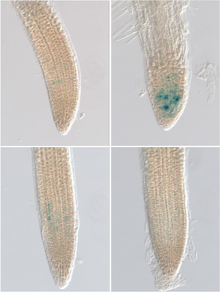
Credit: Megan Rounds and Paul Larsen, Current Biology publication date: Oct 2, 2008 (online) and October 14, 2008 (print)
Toxicity-Resistant
Crops
Thursday,
October 02, 2008
Researchers
have engineered aluminum-tolerant crops.
By
Mason Inman
(Note: If aluminum is common in soils, why is it just now necessary to develop aluminum-resistant crops? How did they grow before, with so much aluminum in the soil? Why is aluminum suddenly at such toxic levels? Just a few questions that occur to me -- Ed.)
 |
| Aluminum foiled: When aluminum in
soils gets activated by acidic conditions, it damages plants' DNA. In
response, normal root cells stop in the middle of dividing (top row).
But in plants with a mutation that makes them blind to the DNA damage,
root cells keep dividing, bypassing aluminum's stunting effects (bottom
row). Credit: Megan Rounds and Paul Larsen, Current Biology publication date: Oct 2, 2008 (online) and October 14, 2008 (print) |
Much of the world's cropland contains
aluminum that stunts crops. But a new study has found a way to make plants grow
tall in spite of the metal's toxic effects. The discovery, by plant biologists
at the University of California, Riverside, suggests that genetic engineering
could boost yields from fields that today are not ideal for growing crops.
Aluminum is common in soils--it's a major
component of clay--but only in acidic soils does the metal form an ion that can
dissolve into liquids and that's toxic to plants. Acidic soils make up as much
as half the world's croplands, however, and aluminum toxicity is the main
factor holding back crop growth in nearly 20 percent of the world's arable
soils, including large areas of the United States east of the Mississippi River
and northwestern Europe.
"The problem is, we have all these
crop plants--wheat and corn and barley and so on--that didn't evolve or get
developed on aluminum-toxic soils," study leader and professor of
biochemistry Paul Larsen says. "They don't have natural resistance or
tolerance to aluminum." Plant breeders are working on developing strains
that can cope better with toxic aluminum, but they have only been able to make incremental
improvements, Larsen says.
In a study in Current Biology, Larsen and his colleague Megan Rounds have
uncovered a simple mutation to a single gene that makes plants thrive in spite
of levels of aluminum that would normally be toxic. Larsen and Rounds found the
gene, called AtATR, by combing through mutants of Arabidopsis,
a member of the mustard family that's commonly used in plant-genetics studies.
The gene is related to a family of proteins known to help with finding and
responding to DNA damage in nearly all multicellular
organisms.
Toxic aluminum ions are known to damage
DNA, and the new study suggests that plants respond by shutting down growth of
cells in the tips of their roots when they accumulate too much DNA damage.
Plants may have evolved this response to help them, over generations, cope with
aluminum's toxic effects, Larsen speculates. But in the short run, it means
that the plants are less healthy and are stunted and more vulnerable to
stressors such as droughts.
From
Article on Monsanto in the Atlantic Monthly:
….The Green Revolution can make Africa productive.
The breakup of the former Soviet Union has caused its grain output to plummet,
but if the new republics recover economically, they could produce vast amounts
of food. More fertilizer can make the favored lands of Latin America --
especially Argentina and Brazil -- more productive. The cerrado
region of Brazil, a very large area long assumed to be infertile because of
toxic soluble aluminum in the soil, may become a breadbasket, because
aluminum-resistant crop strains are being developed." This last is an
example of agricultural advances and environmental protection going hand in
hand…
From USDA Agricultural Research Service:
…Aluminum tolerance in wheat is regulated by the
aluminum-tolerance gene ALTM1. When ALTM1 is activated, it
triggers the release of malic acid, which bonds with
the aluminum and neutralizes its toxic effect.
The research team found a gene in
sorghum that protects the plant from soil aluminum via mechanisms that closely
parallel ALTM1’s activity in wheat. In sorghum, the aluminum tolerance
gene prompts the release of citric acid, which also binds to soil aluminum. But
this sorghum transporter—dubbed SbMATEis not
related to the ALMT1 transporter protein.
The
team found that activity of SbMATE is
activated in the roots of aluminum-tolerant sorghum only when aluminum is
present in the soil. Under these conditions, SbMATE
is most highly expressed in the first centimeter of the tip of the root. This
optimizes the ability of the transporter to neutralize the aluminum and protect
the sensitive root tip….
source: http://www.technologyreview.com/biomedicine/21454/